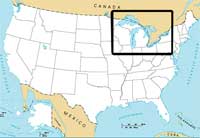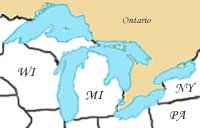The Great Lakes are a group of five large lakes on or near the United States-Canadian border. They are the largest group of fresh water lakes on the earth, and the Great Lakes-St. Lawrence system is the largest fresh-water system in the world. They are sometimes referred to as inland seas.
  The Great Lakes are (west to east, general direction of water flow): The Great Lakes are (west to east, general direction of water flow):
Lake Superior (the largest and deepest, larger than the Czech Republic)
Lake Michigan (the only one entirely in the U.S., the second largest in volume)
Lake Huron (the second largest in area)
Lake Erie (the smallest in volume and shallowest)
Lake Ontario (the smallest in area, much lower altitude than the rest)
A much smaller sixth lake, Lake St. Clair, is part of the Great Lakes system between Lake Huron and Lake Erie, but is not considered one of the "Great Lakes". The system also includes the rivers that connect the lakes: St. Mary's River between Lake Superior and Lake Huron, the St. Clair River between Lake Huron and Lake St. Clair, the Detroit River between Lake St. Clair and Lake Erie, and the Niagara River and Niagara Falls, between Lake Erie and Lake Ontario. (Lake Michigan is connected to Lake Huron through the Straits of Mackinac.) Large islands and a peninsula divide Lake Huron into the lake proper and Georgian Bay.
The lakes are bounded by Ontario (all of the lakes but Michigan), Minnesota, Wisconsin, Michigan (all but Ontario), Illinois, Indiana, Ohio, Pennsylvania, and New York. Four of the five lakes straddle the U.S.-Canada border; the fifth, Lake Michigan, is entirely within the United States. The Saint Lawrence River, which marks the same international border for a portion of its course, is a primary outlet of these interconnected lakes, and flows through Quebec and past the Gaspé Peninsula to the northern Atlantic Ocean.
Sprinkled throughout the lakes are the approximately 35,000 Great Lakes islands, including Manitoulin Island in Lake Huron, the largest island in any inland body of water, and Isle Royale in Lake Superior, the largest island in the largest lake (each island large enough to itself contain multiple lakes).
The Saint Lawrence Seaway and Great Lakes Waterway opened the Great Lakes to ocean-going vessels. However the move to wider ocean-going container ships - which do not fit through the locks on these routes - has limited shipping on the lakes. Despite their vast size, large sections of the Great Lakes freeze over in winter, and most shipping stops during that season. There are some icebreakers that operate on the lakes.
The lakes have an effect on weather in the region, known as lake effect. In winter, the moisture picked up by the prevailing winds from the west can produce very heavy snowfall, especially along lakeshores to the east such as in Michigan, Ontario, and New York. The most infamous example is the Blizzard of '77 in which previous heavy snowfall and strong winds running the length of Lake Erie covered Buffalo, New York in drifting snow. The lakes also moderate seasonal temperatures somewhat, by absorbing heat and cooling the air in summer, then slowly radiating that heat in autumn. This temperature buffering produces areas known as "fruit belts", where fruit typically grown farther south can be produced in commercial quantities.
 The Great Lakes were formed at the end of the last ice age, about 10,000 years ago, when the Laurentide ice sheet receded. When this happened, the giant glacier scratched a deep hole within the Earth's surface. The melting also left behind a large amount of meltwater which filled up these holes, which were soon to become the Great Lakes. Because of the uneven nature of glacier erosion, some higher hills became Great Lakes islands. The Niagara Escarpment follows the contour of the Great Lakes between New York and Wisconsin. The Great Lakes were formed at the end of the last ice age, about 10,000 years ago, when the Laurentide ice sheet receded. When this happened, the giant glacier scratched a deep hole within the Earth's surface. The melting also left behind a large amount of meltwater which filled up these holes, which were soon to become the Great Lakes. Because of the uneven nature of glacier erosion, some higher hills became Great Lakes islands. The Niagara Escarpment follows the contour of the Great Lakes between New York and Wisconsin.
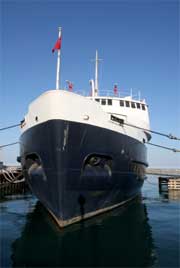 The lakes are extensively used for transport, though cargo traffic has decreased considerably in recent years. Storms and reefs are a common threat, and many thousands of ships have sunk in these waters, the number estimates varying widely. The SS Edmund Fitzgerald was the last major freighter lost on the lakes. The Great Lakes Waterway makes each of the lakes accessible. The lakes are extensively used for transport, though cargo traffic has decreased considerably in recent years. Storms and reefs are a common threat, and many thousands of ships have sunk in these waters, the number estimates varying widely. The SS Edmund Fitzgerald was the last major freighter lost on the lakes. The Great Lakes Waterway makes each of the lakes accessible.
During settlement, the Great Lakes and its rivers were the only practical means of moving people and freight. Anything and everything floated on the lakes. Some ended up on the bottom due to storms, fires, collisions and underwater hazards. Barges from middle North America were able to reach the Atlantic Ocean from the Great Lakes when the Erie Canal opened in 1825. By 1848, with the opening of the Illinois and Michigan Canal at Chicago, direct access to the Mississippi River was possible from the lakes. With these two canals an all-inland water route was provided between New York City and New Orleans.
 The main business of many of the passenger lines in the 1800s was transporting immigrants. Many of the larger cities owe their existence to their position on the lakes as a freight destination as well as for being a magnet for immigrants. After railroads and surface roads developed the freight and passenger businesses dwindled and, excepting ferries and a few foreign cruise ships, now has vanished. The main business of many of the passenger lines in the 1800s was transporting immigrants. Many of the larger cities owe their existence to their position on the lakes as a freight destination as well as for being a magnet for immigrants. After railroads and surface roads developed the freight and passenger businesses dwindled and, excepting ferries and a few foreign cruise ships, now has vanished.
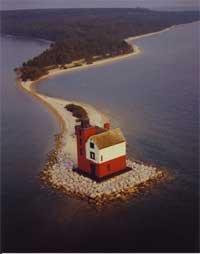 Since general freight these days is transported by railroads and trucks, domestic ships mostly move bulk cargoes, such as iron ore and its derivatives, coal and limestone for the steel industry. The domestic bulk freight developed because of the nearby mines. It was more economical to transport the ingredients for steel to centralized plants rather than try to make steel on the spot. Ingredients for steel, however, are not the only bulk shipments made. Since general freight these days is transported by railroads and trucks, domestic ships mostly move bulk cargoes, such as iron ore and its derivatives, coal and limestone for the steel industry. The domestic bulk freight developed because of the nearby mines. It was more economical to transport the ingredients for steel to centralized plants rather than try to make steel on the spot. Ingredients for steel, however, are not the only bulk shipments made.
Because the lake maritime community largely developed independently, it has its own language. Ships, no matter the size, are referred to as boats. When the sailing ships gave way to steamships, they were called steamboats—the same term used on the Mississippi. The ships also have a distinctive design. Ships that primarily trade on the lakes are known as lakers. Foreign boats are known as salties.
The Great Lakes are used as a major mode of transport for bulk goods. The brigantine Le Griffon, which was commissioned by René Robert Cavelier, Sieur de La Salle, was towed to the southern end of the Niagara River, to become the first sailing ship to travel the upper Great Lakes on August 7, 1679.
In 2002, 162 million net tons of dry bulk cargo was moved on the Lakes. This was, in order of volume: iron ore, coal, stone, grain, salt, cement and potash. The iron ore and much of the stone and coal are used in the steel industry. There is also some shipping of liquid and containerized cargo but most container ships cannot pass the locks on the Saint Lawrence Seaway because they are too wide. The total amount of shipping on the lakes has been on a downward trend for several years.
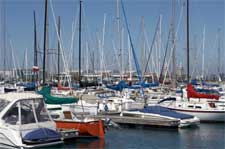 Recreational boating and tourism are major industries on the Great Lakes. A few small cruise ships operate on the Great Lakes including a couple of sailing ships. Several ferries operate on the Great Lakes to carry passengers to various islands. Sport fishing, commercial fishing, and Native American fishing represent a 4 billion dollar (USD) a year industry with salmon, whitefish, smelt, lake trout, and walleye being major catches. Recreational boating and tourism are major industries on the Great Lakes. A few small cruise ships operate on the Great Lakes including a couple of sailing ships. Several ferries operate on the Great Lakes to carry passengers to various islands. Sport fishing, commercial fishing, and Native American fishing represent a 4 billion dollar (USD) a year industry with salmon, whitefish, smelt, lake trout, and walleye being major catches.
The Great Lakes are used to supply drinking water to tens of millions of people in bordering areas. This valuable resource is collectively administered by the state and provincial governments adjacent to the lakes.
|
